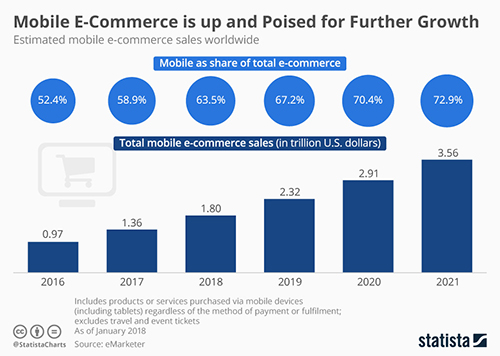Why You Need a Responsive Website In 2020?
The usage of mobile internet has worked its way into the daily life of consumers in the United States, mainly due to the popularity and the rise of mobile devices. According to statista.com as of 2019 the mobile phone internet user penetration in the United States is 81.9 percent and is projected to grow to 84.8 percent by 2023.
This clearly shows the potential audience for your website on mobile phones. Therefore having a responsive website is no more an option but has become an important online business strategy today.
What is a Responsive Website?
A responsive website is one that has been designed to render, or respond, based on the device used by the visitor to display the site. It is basically one website design that will adapt the layout to the viewing environment — from a large desktop LCD monitor to the smaller screens we use on Smartphone and tablets. It is also popularly known as a mobile-friendly web design.
A responsive design helps user to avoid the inessential resizing, scrolling, zooming, or panning and target tapping issues that occurs with websites that have not been optimized for different devices sizes.
Why You Need a Responsive Website?
Let’s look into some of the important factors that contribute towards having a responsive website in today’s online space.
Increase in Mobile Traffic
As of March 2019, the Mobile internet traffic as percentage of total web traffic in the United States is 42.17 percent. This percent is expected to rise in the coming years. Therefore with such high traffic from mobile you cannot ignore having a proper mobile responsive website.
If your website is outdated, unresponsive, or just unsuited for mobile, you’re missing opportunities to convert this high mobile traffic into sales or signups. Visitors won’t continue to use a website that isn’t responsive.
Mobile E-commerce is on the rise
If you run an online ecommerce store with a non responsive website, then this should be your wake-up call. The mobile ecommerce is up and poised for further growth in years to come. The current and projected total mobile ecommerce sales of products or services purchased via mobile devices can be seen in the below graph.
Google Recommended
Responsive design is Google’s recommended design pattern. Today, everyone has a Smartphone with them, constantly communicating and looking for information. In many countries, the number of Smartphone has surpassed the number of personal computers. Therefore having a mobile-friendly website has become a critical part of having an online presence. If you haven’t made your website mobile-friendly, you should as the majority of users coming to your site are likely to be using a mobile device.
Good for SEO – Ranking and Indexing
On April 21, 2015, Google released a significant new mobile-friendly ranking algorithm (also called Mobilegeddon) that’s designed to give a boost to mobile-friendly pages in Google’s mobile search results.
Starting July 1, 2019 Google is migrating to mobile-first indexing. Mobile-first indexing means Google predominantly uses the mobile version of the content for indexing and ranking. Therefore websites that are not mobile friendly should optimize their websites for mobile version.
A responsive website gives you the SEO edge against your competitors in the following ways:
- Lowering your website Bounce Rates
- Increasing visitor dwelling time
- Improves mobile browsing experience
- Helps in improving mobile search rankings
- Increase your overall conversion and online presence
Lower Website Maintenance Cost
Maintaining two separate versions of a website – that is one for desktop and another for mobile increases cost. This setup requires two administrative interfaces, different content strategies, and different design teams thus resulting in more expenses. Therefore the benefit of using a responsive website theme offers a lower maintenance cost opposed to multiple versions of a single website.
Better User Experience increases conversion
Responsive website provides a more seamless and better user experience compared to a non-responsive website. The most common issues faced by non-responsive websites are
- Clickable elements are placed too close together
- Text are too small to read
- Content wider than the screen
A responsive website has the high potential to turn users into customers. The fastest path to mobile customers is through a mobile-friendly site. If your site offers a great mobile experience, users are more likely to make a purchase. 67% of mobile users say that when they visit a mobile-friendly site, they’re more likely to buy a site’s product or service
Easier To Manage Analytics & Marketing Efforts
Responsive websites promote social media marketing. If you want to have a balanced social media campaign, a responsive webpage can complement all your efforts. Responsive web design is built to make social sharing easy for mobile users.
Having a separate desktop and mobile site requires having separate Google Adwords campaigns, SEO campaigns and separate Google Analytics reports. Managing one site is of course, far easier than managing two sites and makes managing your analytics easy.
Final Words
With mobile phones being increasingly used for searching and making purchases online, you need to provide the audience a mobile-friendly responsive website. So making your website responsive is an essential aspect of your online presence.
Please contact us at PARSIDIO for further discussion on how we might be able to assist you and your team in developing a mobile responsive website for your business.





